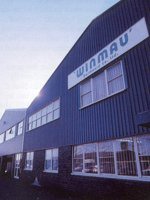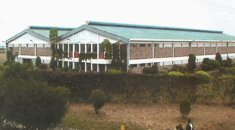|
The Nodor- Winmau Story A Brief History... How These Two Companies Merged by Frank Bilotta with Patrick Chaplin, the Darts Historian
Let’s wind back the clock to 1919 when an industrial chemist, Ted Leggatt, invented and then went into business manufacturing ‘NODOR’ modelling clay. It was called Nodor because, unlike its main competitor, it had no odour. Since the end of the Great War, the popularity of darts had increased significantly causing Leggatt to experiment with Nodor plasticine as a material for possible use in the construction of dartboards. In 1923, the first Nodor plasticine dartboard was marketed. It was not generally popular with the dart playing public because it lacked the ‘plonk’ sound as the dart struck the dartboard. A sound that was familiar to all those who played on the notorious wooden elm boards. By 1924, Leggatt had added elm dartboards to Nodor production, and by 1928, brass darts are added to the range of products. During 1931, Frank Dabbs, a Kent publican, approached Leggatt with an idea for a new dartboard construction, namely short pieces of rope laced vertically and bound to form a circular playing surface. Leggatt refines the idea and files for a Patent along with Dabbs. By 1935, the Nodor ORIGINAL BRISTLE dartboard is launched. Leggatt helps found the National Darts Association and becomes it’s first President. At about the same time, the present day ‘clock’ pattern is adopted as the standard for dartboards worldwide. During World War II, dartboard production was moved to Devon as a precaution, and manufacturing continued despite a shortage of raw materials. In 1945, production moved back to London’s East End. In 1959, Dunlop contracted to buy and sell exclusively all Nodor dartboard capacity, but by 1966, the contract ended. Leggatt had retired and the company was purchased by Fred Grisley, Leggatt’s brother-in-law. In 1968, Nodor was approached with a proposal to transfer their factory to South Wales, an area of high unemployment. Eventually, the company relocated to Cardiff. It was in 1983 that the current owners, the Bluck family, headed by John Bluck, acquired Nodor and moved its factory to Bridgend. Bluck already had an involvement with the darts industry via his company, Brackla Engineering, a leading manufacturer of tungsten darts. By 1984, his company had invented and patented the first staple-free bullseye, Supabull which quickly took the market by storm. With the creation of Red Dragon mail order darts equipment in 1976, and much to the chagrin of Brackla’s competitors, tungsten darts were priced to suit the pocket of the working man. Recognizing the increasing threat from poor quality, low priced dartboards from the Far East, Bluck reluctantly, but bravely made the decision in 1999 to move the dartboard production to Kenya, Africa, home of the best sisal in the world. Sisal is the key ingredient for bristle dartboards. Nodor has always insisted on using prime East African sisal which also happens to be the preferred choice of the British Admiralty for marine ropes.
In 1945, just down the road from Nodor in the East End of London, Harry Kicks Senior invested his demob money in establishing an elm dartboard manufacturing company. It was first located in a bomb damaged building and used only a paraffin lamp for light, a coal fire for heat and his father for hand painting the colours on the dartboards. He delivered the dartboards, by hand, using London’s Underground System to the Watney Brewery, his first customer. Around 1952, he began to make dartboard cabinet by hand, including French polishing and applying graphic transfers supplied by the Breweries. Soon afterwards, Kicks began manufacturing paper-coil dartboards under the brand name Keep Dry as they did not require soaking, unlike the elm dartboards. By 1960, the Keep Dry brand name was sold to Scotts Dartboards of Southend, a specialist manufacturer of paper boards. Kick’s eldest son, Harry Kicks, Junior, joined the business at this time. Three years later, Ian Kicks, joined the company. After the Nodor bristle dartboard patent had expired, the Kicks business began to manufacture bristle dartboards from a stable block in the East End under the company name H.A.Kicks and Sons. The company was forced to move in 1989 because of a compulsory purchase order, to make way for a block of high rise flats to be built. The company relocated to its current location in Haverhill, Suffolk. All went well until the U.K. was hit by Dutch Elm Disease and all production shifted to bristle dartboards. The business slowly prospered, establishing a reputation for quality. In 1973, Harry Kicks Senior achieved a major breakthrough deal with Olly Croft of the British Darts Organization (BDO), the governing body for darts in the U.K. From then on, the H.A.Kicks dartboards would be the official dartboards of the BDO and be allowed to carry its logo and would appear in many international darts tournaments. By the mid-seventies, Kicks changed the company name to Winmau (pronounced Win More) using the first three letters of his wife’s first two names, Winifred Maud. The sudden death of Harry Kicks, Senior in 1984 resulted in the transfer of ownership of Winmau to his five sons. With the heyday of televised darts now past, trading conditions became extremely difficult. After several years of financial losses, the company was close to insolvency. In 1993, the brothers approached their U.S. distributor, Accudart, Inc., for financial support, attempting to keep the company afloat. Ron Kurtz, the owner of Accudart, Inc., agreed and became the majority shareholder in the company. Within two years of appointing specialists in the business of turning companies around, the business was back to making profits and has continued to do so ever since. In 1995, development work began on the most technically advanced bristle dartboard in the world. By 1997, The Blade dartboard was launched as the ultimate no-bounce out dartboard using sophisticated staple free technology. That same year, Winmau was voted Mid-Anglia Business of the Year, beating Ryanair. Throughout its period of severe financial difficulties, the company remained committed to the BDO. In 2003, the 30th Winmau World Masters Dart Tournament will take place. This famous tournament is represented by more than twenty-five countries around the world and is often televised. Winmau’s sponsorship affiliation with the World Masters make it one of the longest serving sponsors of a sporting event. During the last twenty-five years, there has been a bitter rivalry between Nodor and Winmau. Several unsuccessful attempts have been made for one to acquire the other. However, this healthy competition to be the ‘number one’ dartboard manufacturer has also driven each company to marvellous technical innovations and creative marketing activities that has ultimately benefited the consumers. In 2002, after nearly three decades of competition, Nodor successfully acquired Winmau. Within less than one year, there has been a seamless transfer of production to Kenya.
© 2003 Patrick Chaplin and Bracklanodor International
|
 The British history of dartboard manufacturing is a fascinating story that
started in earnest in the early part of the twentieth century and is still
taking interesting twists and turns. This story is about two companies that
have been at the forefront of the darts industry for many decades and jointly
have had a major positive influence over the sport. Interestingly, both
Winmau and Nodor were originally founded in the East End of London and until
recently, were arch rivals.
The British history of dartboard manufacturing is a fascinating story that
started in earnest in the early part of the twentieth century and is still
taking interesting twists and turns. This story is about two companies that
have been at the forefront of the darts industry for many decades and jointly
have had a major positive influence over the sport. Interestingly, both
Winmau and Nodor were originally founded in the East End of London and until
recently, were arch rivals.
 Valued support from the Kenyan authorities made the difficult transition easier.
Discussions with Dickson Mbugua, the Commercial Attaché at the Kenya High
Commission in London, followed by many meetings and encouragement from Albert
Gumo, chief Executive EPZA in Nairobi, resulted in the decision to set up
production at the Athi River Export Processing Zone. The EPZ Authority
has operations in several countries worldwide. It’s primary aim is to encourage
inward investment. First, renting factory space, the company now owns its own
factory and warehouse complex. Nodor manufactures quality dartboards with a
skilled local work force and uses the most advanced manufacturing techniques,
developed by Nodor’s own engineers, seen in the industry.
Valued support from the Kenyan authorities made the difficult transition easier.
Discussions with Dickson Mbugua, the Commercial Attaché at the Kenya High
Commission in London, followed by many meetings and encouragement from Albert
Gumo, chief Executive EPZA in Nairobi, resulted in the decision to set up
production at the Athi River Export Processing Zone. The EPZ Authority
has operations in several countries worldwide. It’s primary aim is to encourage
inward investment. First, renting factory space, the company now owns its own
factory and warehouse complex. Nodor manufactures quality dartboards with a
skilled local work force and uses the most advanced manufacturing techniques,
developed by Nodor’s own engineers, seen in the industry.
 Today, Nodor International is the oldest and largest group of companies
servicing the darts industry. It owns two flagship dartboard brands that are
known throughout the world for quality, durability, service, and value for
the money. Both brands have a fantastic heritage built on uncompromising
attention to detail and use of the best raw materials available. In Kenya,
over 200 tons of sisal leaves are cut daily to produce the dartboards. The
business continues to reinvested back into the sport in the form of product
development and research, player sponsorships, international tournament
sponsorships and hand-made regional dartboards, such as London’s 5’s and
Yorkshire. To date, the company has sold nearly 40 million dartboards to
over 50 different countries worldwide, and plans to continue doing so long
into the future.
Today, Nodor International is the oldest and largest group of companies
servicing the darts industry. It owns two flagship dartboard brands that are
known throughout the world for quality, durability, service, and value for
the money. Both brands have a fantastic heritage built on uncompromising
attention to detail and use of the best raw materials available. In Kenya,
over 200 tons of sisal leaves are cut daily to produce the dartboards. The
business continues to reinvested back into the sport in the form of product
development and research, player sponsorships, international tournament
sponsorships and hand-made regional dartboards, such as London’s 5’s and
Yorkshire. To date, the company has sold nearly 40 million dartboards to
over 50 different countries worldwide, and plans to continue doing so long
into the future.